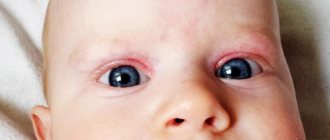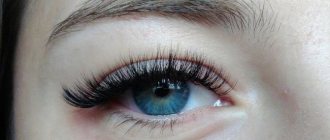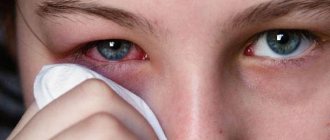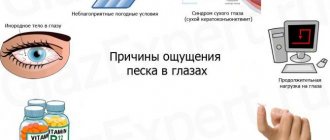Classification of main types of injuries
Based on severity, eye injury can be divided into several types. Damage to the organs of vision can be:
- Minor trauma has virtually no effect on visual function.
- Moderate damage causes only short-term vision loss.
- Severe injury is associated with permanent impairment of visual function.
- Particularly severe injuries lead to complete loss of visual function or even the eye itself.
An injury of any severity can be caused by a simple blow inflicted by a hand or other object. Such a blow is not always done intentionally.
Hitting a child with the eye: tissue bruises
If a child hits his eye, a bruise forms in the area of the affected tissue. This is a specific mechanical tissue injury that may not leave an open wound. Often, with a bruise, swelling of the tissues and bruises form, and painful sensations occur. A mild bruise usually passes without consequences, but with severe damage to the eyeball, visual functions can be significantly impaired, up to complete blindness for some time or forever. This leads to permanent disability and restrictions in normal life. There are features in the structure and functioning of the organ of vision, due to which even seemingly minor and insignificant damage can be dangerous. They are associated with the structural features of the visual analyzer in children.
The eye area and the analyzer itself differ in structure from many other tissues of the body. The eye does not have a muscular frame to support it; it has only delicate extraocular muscles that do not have a protective function. In addition, the analyzer is in direct contact with environmental factors and is vulnerable to mechanical, physical or chemical injury. The elements in the area of the eye analyzer are delicate and fragile, they are easy to damage, all of their media are liquid. Not all eye problems and the consequences of injuries can be eliminated, so the eyes are considered to be organs that are important to protect as much as possible from injury.
Important
Impacts to the eye and concussions can cause irreversible blindness, retinal detachment and hemorrhages, which are dangerous to health.
Major damage to the organs of vision
A blow to the orbital area causes damage to the eyeball. In addition, there is a so-called contusion of the orbit, which is not accompanied by damage to the integrity of the skin. The eye turns red and visual acuity decreases. The eyeball becomes limited in movement.
If the injury has damaged the skin, then it is very likely that there is damage to adjacent structures:
- Muscle fibers;
- Lacrimal gland;
- Tear canal.
The first thing you need to do is get tested! For any eye injury, you must see an ophthalmologist. Only after this the doctor will be able to carry out the necessary treatment.
If the eye is red as a result of an impact, the diagnostic examination includes the following techniques:
- Visual inspection;
- Determination of visual acuity;
- Study of corneal sensitivity;
- Tonometry to clarify the level of intraocular pressure.
These methods are basic and mandatory, however, at the request of the doctor, other types of examination can be performed. All this depends on the data received. In addition, the patient often has to consult with other specialists:
- Traumatologist;
- Therapist;
- Neurosurgeon;
- Surgeon.
What to do for various eye injuries
1. Damage to the eye from foreign objects
The main symptom: the child squints and closes his eyes in bright light
What to do: Invite your child to blink. If, when blinking, the speck moves to another place, you can try to rinse the eye with plenty of water at a comfortable temperature. It is important to do this correctly: either put your face under the shower, or water from above from a container.
If the foreign body does not move when blinking, the situation is bad. This means that it has penetrated into the lining of the eye. In this case, you need to cover your eye with a clean scarf or gauze pad and go to the doctor.
Under no circumstances should you rub the eye or try to remove the foreign body yourself: in this case, it will penetrate deeper and further injure the eye.
Scratches, abrasions and burns: how to provide first aid to a child? More details
2. Eye contusion (concussion)
Occurs when struck or bruised by a blunt object (such as a soccer ball).
Main symptoms: bruise around the eye.
What to do: Apply cold to the eye (any bottle from the refrigerator will do) and observe further developments. Medical attention will be needed if the child’s temperature rises or the child’s vision becomes worse with the damaged eye.
Article on the topic
The school got in the eye. How to prepare your child's vision for school
3. Contact with eye chemicals (most often household chemicals)
Symptoms : the child holds his eye, cannot open it, complains that it stings.
What to do: Rinse the eye with plenty of water (in the shower or pouring water at a comfortable temperature for at least 10-15 minutes). Do not rinse if dry chemicals get into the eye. In this case, you should try to remove them with a clean cloth or sterile gauze, and then immediately go to the doctor.
4. Eye burn (steam, fire from a fire, oil from a frying pan)
Symptoms : pain, swelling, inability to open the eye, blurred vision, sensation of a foreign body in the eye.
What to do : Rinse the eye with plenty of cold water (15–20 minutes), then apply a gauze bandage to the eye and be sure to call an ambulance (or get to a traumatologist yourself).
Treatment methods
When the eye is red after injury, treatment approaches can be different, depending on the individual parameters obtained during a diagnostic examination. Below are only general recommendations for patients who have suffered eye injuries:
- Instill medications with an antiseptic effect to reduce the risk of infection.
- If there is severe pain, you should go to the emergency room as soon as possible, having first taken an analgesic.
- The doctor may prescribe additional hemostatic drugs, calcium salts and iodine.
- In case of severe eye injury, bed rest should be observed.
Variants of eye injuries in children
A blow to the eye area can be mild, then the swelling and all symptoms of injury disappear in a few days, but there can also be serious injuries that parents need to know about and be on the lookout for. Depending on the location of the injury, the scenarios may vary.
If it is the soft tissue of the eye, hemorrhages can form (“black eye”), if the injury concerns the bony walls of the orbit, the structure of its walls may be disrupted, which increases tissue swelling. There may be damage and ruptures of the eyelid with a violation of the integrity of the structures of the lacrimal canals, which causes profuse lacrimation, blockage of the lacrimal canal by hematoma and swelling. If there are problems with the secretion of tear fluid, the mucous membranes and cornea may dry out, which can lead to loss of vision.
Bruises of the orbits may be accompanied by bleeding from injured vessels in the orbital area. Tissue swelling and damage can lead to gradually increasing exophthalmos (protrusion of the eyeball forward). This disrupts the functioning of the eye analyzer, its mobility, visual acuity suffers, double vision and other defects occur.
In case of injury, the bone walls in the orbit of the eye may suffer, emphysema may develop in the subcutaneous space and pain in the area of the affected bones. The eyeball may become sunken, the upper eyelid may sag below normal limits, and vision may completely disappear.
Effective treatment for redness
Drops will help relieve this manifestation.
If the squirrel turns red due to a blow, in most cases there is no need for special treatment. It is necessary to monitor the general well-being and condition of the affected organ of vision and “notice” whether new dangerous symptoms have arisen. If the injury is more serious, the doctor may prescribe the following medications to remove redness from the eye:
- maintenance eye drops;
- local antibacterial medications - to prevent the development of inflammation and infection.
You should not use any medications yourself or make lotions or compresses with traditional medicine without consulting your doctor. This can further damage the affected organ of vision.
Consequences of a bruise
In addition to these symptoms, severe injuries can also cause very serious consequences:
- Disturbances in the structure of the retina or its detachment. It occurs when the capillaries cannot withstand the force of the impact and rupture. The risk group includes people with retinal dystrophy and other pathologies.
- Problems with the cornea. Traumatic cataracts, clouding or even destruction of the lens may develop.
- Ligament rupture. When they are damaged, the lens is the first to suffer and loses its transparency.
- A rupture of the iris leads to the fact that the pupil loses its functions of constriction and dilation, that is, it stops responding to light. This indicates damage to the nerve endings.
- Bleeding inside the eye - indicates the likelihood of retinal detachment and further deterioration of visual functions; it appears a minute after receiving a blow.
Causes of redness
After an injury to the organ of vision, a red spot appears on the eye. The main factors behind bruises are everyday situations. In all cases, injury occurs due to mechanical impact. The most common is a blow: a ball or other object hitting the head during a game, a blow during sparring or a fight, etc. Any person can get a bruise, but most often athletes, children, military personnel and people whose work is subject to this type of injury increased physical activity is required.
The cause of injury is the transfer of kinetic energy from the body to the eyeball and orbit. As a result, blood vessels rupture and tissue damage.
First aid
Let's look step by step what needs to be done after an impact:
- Give your eyes complete rest. Any physical activity should be avoided. Don't even turn your head or move your eyeball.
- Apply cold. You can wet a towel with cold water or wrap ice cubes in a cloth. Cold is applied to the eye through closed eyelids, and the temporal part should also be involved. Apply the towel for fifteen minutes and repeat after ten minutes.
- Place disinfectant drops into the conjunctival sac.
- A sterile bandage must be applied to the eye. This will relieve hypersensitivity to light.
- For acute pain, you can apply cold compresses, which are changed every fifteen minutes.
- In case of severe pain, take an analgesic.
- Immediately take the victim to a specialized facility.
- Use Polimedel electret film. It can be used for up to four hours. The device normalizes blood circulation, tissue nutrition and metabolism. As a result, the healing process is accelerated.
If your eye turns red after being hit, consult an ophthalmologist
How are traumatic injuries diagnosed?
Parents themselves will not be able to assess all possible vision problems after an impact, so even with a minor injury it is worth contacting an ophthalmologist. The doctor will conduct an external examination and additional research techniques necessary in a given situation, initially assessing the method of injury. The use of ophthalmoscopy or ophthalmochromoscopy, ultrasound of the eye and tonometry is indicated; if necessary, radiography of the orbits and additional methods for assessing vision are performed.
note
In many cases of minor injuries, the doctor will only examine the environment of the eye and external damage to the eyelids and tissues, prescribing appropriate treatment.
Prevention and prognosis
The prognosis for successful recovery depends on the nature and degree of injury to the visual organs. If the damage is superficial, not severe, and the victim seeks medical help in a timely manner, the risk of developing negative consequences is minimized, and after a while the person will be able to see fully. Otherwise, complications develop, as a result of which vision may be completely lost, and the person will become disabled.
As a preventive measure, it is necessary to follow safety rules: when performing traumatic work, always use safety glasses and a helmet, while walking, look carefully in front of you, and move carefully in places where there are a lot of branches and bushes. In addition, it is important to protect the organs of vision from intentional impacts, always wear seat belts in the car, and those who like to ride a motorcycle should not forget about a special helmet, which in the event of an accident will take the main load when hitting the head. Children should also be aware of the rules of safe behavior at home, in the yard and at school.
What complications will occur if left untreated?
Eye injury can be dangerous in its consequences. This is not a situation where a trip to the ophthalmologist can be neglected. There is a risk of serious consequences for the eye, one of which is retinal detachment. From the point of view of diagnostic measures, it is important to exclude the occurrence of dangerous complications. Only a qualified specialist can handle this task. It is important to know that due to injury to the organ of vision, in some situations, visual acuity can sharply decrease, inflammation in the brain can develop, and even complete blindness can occur.
Clinical symptoms
Contusion of the visual organ manifests itself in the form of the following symptoms:
- impaired movement of the eyeball;
- redness of the conjunctiva;
- hemorrhage into the white of the eye;
- swelling, pain, pain;
- worsening reaction to light;
- bulging or sinking of the eyeball;
- drooping upper eyelid;
- blurred vision;
- diplopia – double vision;
- the palpebral fissure does not close;
- continuous tearing;
- involuntary closing of the eyelids;
- nausea, dizziness, headache;
- in severe cases, loss of consciousness is possible.
Excessive lacrimation occurs due to a violation of the integrity of the tear ducts
A minor contusion does not always manifest itself as typical symptoms of eye injury. For example, a branch that hits the eye or a bounced ball can only hit the superficial layers and not cause pain.
Treatment methods for eye bruises in children
Often, household eye injuries are not very severe, and treatment is carried out using a standard course of therapy. Often all you need is rest and compresses to relieve swelling, but more serious measures may be needed. The doctor can use drops to normalize eye function, antibacterial solutions to prevent secondary infections, drugs to resolve hematomas and prevent hemorrhages.
If there is severe swelling and pain, anti-inflammatory and painkillers will be indicated locally or orally. As the condition improves, warm compresses to resolve swelling and hematomas, magnetic therapy with electrophoresis, and UHF therapy may be indicated.
note
In case of eye injuries and hematomas, severe swelling, practice self-medication, this can lead to serious complications. It is important to use all medications only as directed by your doctor.
In addition, it is important to prevent injuries in children by supervising their play and teaching them about safety.
Alena Paretskaya, pediatrician, medical columnist
22, total, today
( 45 votes, average: 4.38 out of 5)
Dislocation of the lower jaw: symptoms, treatment, methods of reduction
Dislocation of the leg in the ankle area: symptoms and treatment









